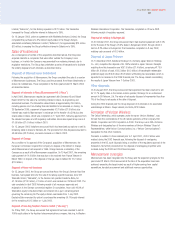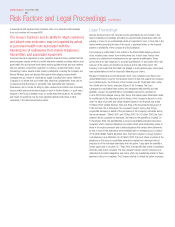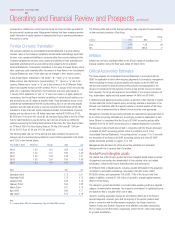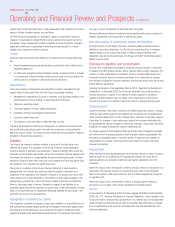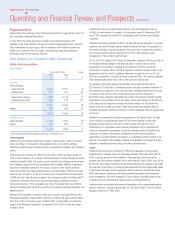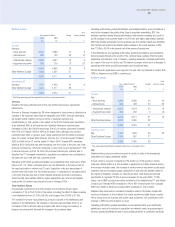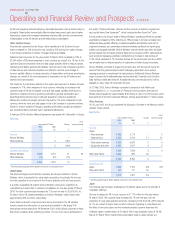Vodafone 2004 Annual Report Download - page 27
Download and view the complete annual report
Please find page 27 of the 2004 Vodafone annual report below. You can navigate through the pages in the report by either clicking on the pages listed below, or by using the keyword search tool below to find specific information within the annual report.
Annual Report 2004 Vodafone Group Plc
25
US GAAP
Under US GAAP, the accounting treatment for goodwill and other intangible assets is
different to that required by UK GAAP and represents the most significant adjustment
made to the Group’s results and financial position under UK GAAP when reconciling to
US GAAP.
The principal differences are:
(a) The allocation of the surplus of the resultant purchase price, over the fair value
attributed to the share of net assets acquired, to a series of identifiable intangible
assets under US GAAP as opposed to only goodwill under UK GAAP;
(b) The US GAAP deferred tax treatment of intangible assets, which increases
acquisition liabilities;
(c) The difference in goodwill arising as a result of the different basis by which the
purchase price is derived under US GAAP.
Of these adjustments, the only one to involve significant management judgement and
estimation is (a). Allocation of the purchase price affects the future results of the
Group under US GAAP, as finite-lived intangibles are amortised whereas indefinite-
lived intangible assets are not amortised, and could result in differing amortisation
charges based on the allocation to goodwill, indefinite-lived intangible assets and
finite-lived intangible assets.
Bases of amortisation
Goodwill
Once capitalised, goodwill is amortised on a straight-line basis over its estimated
useful economic life.
Other intangible assets
Other intangible assets primarily represents the Group’s aggregate amounts spent on
the acquisition of 2G and 3G licences, stated after deduction of related amortisation
charges.
Since revenues cannot be generated until a network is available for commercial
service, amortisation of capitalised licences begins at this time. As networks are
typically brought into service over a period of time, the charge for amortisation is
initially calculated by reference to the capacity of the network compared to capacity at
network maturity. For this purpose, network maturity is determined as being reached
after a maximum period of five years from service launch. Thereafter, amortisation is
on a straight-line basis over its remaining useful economic life. Management
considers this policy is the appropriate method of matching the amortisation with the
economic benefit derived from the licences.
If the licences were amortised over their economic life on a straight-line basis, the
annual amortisation charge would be higher in the period to network maturity and
lower thereafter.
US GAAP
Goodwill and other indefinite-lived intangible assets are not amortised but reviewed
annually for impairment. Impairment reviews are discussed in more detail below. The
majority of the Group’s intangible assets, primarily 2G and 3G licences, are finite-lived
and are amortised over their estimated economic life on a straight-line basis, which
commences when the network is available for commercial service.
Estimation of useful economic life
The economic life used to amortise goodwill and other intangible fixed assets relates
to the future performance of the assets acquired and management’s judgement of the
period over which economic benefit will be derived from the asset.
Goodwill
For acquired mobile network operators, the useful economic life of goodwill reflects
the useful economic life of the licences acquired with those businesses up to a
maximum of twenty-five years. In management’s view, such businesses cannot
operate in their respective jurisdiction without a licence, and so the licence term is the
most appropriate life for the goodwill. The useful economic lives are reviewed annually
and revised if necessary.
For other businesses acquired, the useful economic life principally reflects
management’s view of the average economic life of the acquired customer base. The
useful economic life is assessed by reference to customer churn rates. An increase in
churn rates may lead to a reduction in the useful economic life and an increase in the
amortisation expense. Historically, changes in churn rates have been insufficient to
impact the useful economic life.
Other intangible assets
For licence and spectrum fees, the estimated useful economic life is, generally, the
term of the licence. Using the licence term reflects the period over which the Group
will receive economic benefit. The economic lives are periodically reviewed, taking into
consideration such factors as changes in technology. Historically, the economic lives
have not been changed following these reviews.
Tangible fixed assets
Tangible fixed assets also represent a significant proportion of the asset base of the
Group and hence the estimates and assumptions made to determine their carrying
value and related depreciation are critical to the Group’s financial position and
performance.
Estimation of useful economic life
The charge in respect of periodic depreciation is derived after determining an estimate
of an asset’s expected useful life and the expected residual value at the end of its life.
Increasing an asset’s expected life or its residual value would result in a reduced
depreciation charge in the Group’s profit and loss account.
The useful economic lives of Group assets are determined by management at the time
the asset is acquired and regularly reviewed for appropriateness. The lives are based
on historical experience with similar assets as well as anticipation of future events,
which may impact their life, such as changes in technology. Furthermore, network
infrastructure cannot be depreciated over a period that extends beyond the expiry of
the associated licence under which the operator provides telecommunications
services.
Historically, changes in useful economic lives have not resulted in material changes to
the Group’s depreciation charge.
Cost capitalisation
Cost includes the total purchase price and labour costs associated with the Group’s
own employees to the extent that they are directly attributable to construction costs, or
where they comprise a proportion of a department directly engaged in the purchase or
installation of a fixed asset. Management judgement is involved in determining the
appropriate internal costs to capitalise and the amounts involved. For the year ended
31 March 2004, internal costs capitalised represented approximately 6% of
expenditure on tangible fixed assets and approximately 4% of total operating
expenses, excluding goodwill amortisation.
Impairment reviews
Asset recoverability is an area involving management judgement, requiring
assessment as to whether the carrying value of assets can be supported by the net
present value of future cash flows derived from such assets using cash flow
projections which have been discounted at an appropriate rate. In calculating the net






